|
The non-impact origin of the Libyan Desert
Glass (LDG)
-- an unique opaline glass of volcanic origin
(hyalite group) --
Norbert Brügge, Germany
Dipl.-Geol.
Upload: March 2006
Update: 21.12.2020
|

LDG with Cristobalite
|
The strewn field of the Libyan Desert
Glass (LDG) is located in the Western Desert of Egypt nearby the Libyan
border (part of the Great Sand Sea). The area is occupies with high
parallel sand dunes, which extend from north to south direction more
as hundred kilometers in length. As centre is assumed an area, which
is expands about 20 km from W to E and about 50 km from N to S around
the position at 25� 25' N and 25� 30' E. The occurrence of silica-glass
was documented for the first time by Patrick A. Clayton in 1932.
It is supposed, that on a plain of about 6500 km2 a mass of ~1400 tons
of LDG is distributed. The most productive locations therefore are directly
in the north of Gilf Kebir plateau.
The Libyan Desert Glass (LDG) is in its
chemical and physical characteristics absolutely unique and with no
other natural glass comparable (volcanic glass, tektites and impact
glass). Nevertheless should be evidences for an impact origin the presence
of schlieren and partly digested mineral phases, and Lechatelierite
(a high-temperature mineral melts of quartz, however at slight pressure),
and Baddeleyite, a high-temperature breakdown product of Zircon. But
the so characteristic inclusions of small crystals of alpha-Tridymite
and alpha-Cristobalite are missing in impact glasses. Also typical for
tektite are spherical or drops - formed aerodynamic forms.
There are however also differences between the LDG and the "classical"
impact glasses, mainly by the chemistry. LDG is a very silica-rich natural
glass with about 95.5 - 99 wt.% SiO2, and shows a limited variation
in major and trace element abundances. The degree of hardness (MOHS)
is 6, the specific weight is 2.2 g/cm3, the refractive index is 1.46.
The viscosity is essentially greater than at tektites. The melting point
is with 1727-1713� C more as 500� higher, than which other natural glasses.
The Desert Glass differs from the Tektites also by higher capacity of
water inclusions (0.050 - 0.200 wt.%). The colours of the LDG's varies
from light-yellow, honey-yellow, green-yellow, milky-white to black-grey.
At the surface deposited fragments are polished often by the wind erosion,
in sediment sticking fragments have sharp corners, are not gleaming,
and sand grains are stuck. In macroscopic examination, the glass shows
no impact tracks (JUX,1983), in some fragments are however schlieren,
which point to internal movements in the material at high temperatures.Tiny,
irregularly formed bubbles, and light- and dark-brown bands can enforce
the homogeneous glassy mass. Is the concentration of bubbles high, the
Desert Glass appears milky - white and is opaque. Beside the bubbles
different kinds of further inclusions are to be recognized. To this
(e.g.) belong smallest crystal-grains of quartz similar minerals alpha-Tridymite
and alpha-Cristobalite.
|
|
MURALI et al. 1997; ROCCHIA et al. 1996;
KOEBERL 1997 have found that the contents of siderophile elements, such
as Co, Ni and Ir, are significantly enriched in some rare, dark bands
that occur in some LDG samples. KOEBERL (1997) studied such dark bands
and found that the contents of Fe, Mg, and Ni are high in the dark zones
and low in the "normal" LDG. TEM investigation of the dark streaks (PRATESI
et al. 2002) also revealed the presence of small amorphous Fe-rich silicate
spherules, within the silica-glass matrix, resulting from silicate-silicate
liquid immiscibility.
|
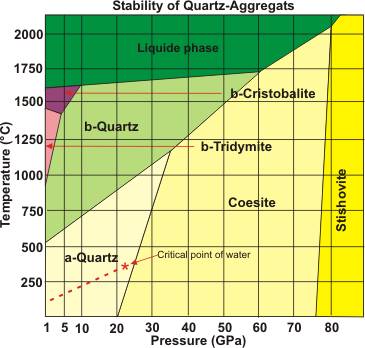
|

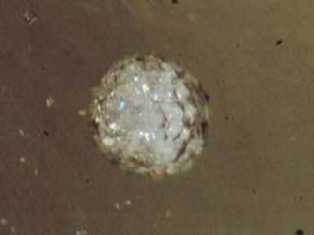
Aggregats of alpha-Cristobalite
in the LDG
|
|
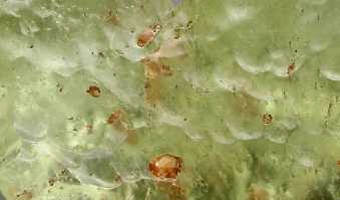

|
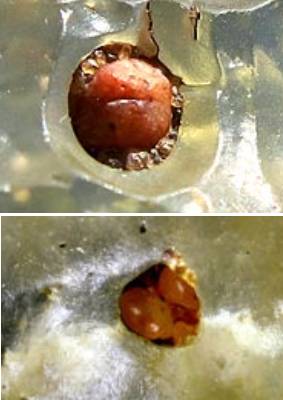
Two mysterious inclusions
|
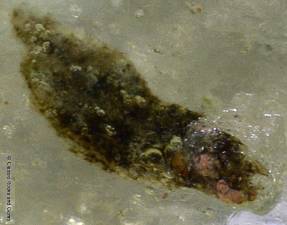
Pyroxene inclusion !?

LDG with many unidentified
inclusions

Fluidal structure

Inclusions of gas bubbles
and a drop of dark glass.
The elongated shape of the inclusions indicates a flow
of the glassy mass in the gel state. Source: Richard de
Nul
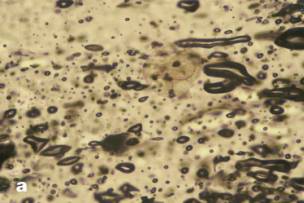
Elongated gas bubbles. Source:
E.Diemer
|
|
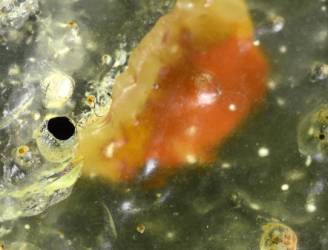
Unknown inclusion
|

LDG with many different
inclusions
|
|

|
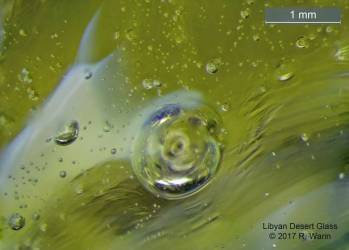
"Drop"
|
|
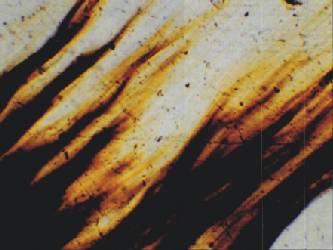
Flowing dark stripes (Köberl,
Univ. Wien)
|

Brownish streaks and unidentified
inclusions (Köberl, Univ. Wien)
|
|
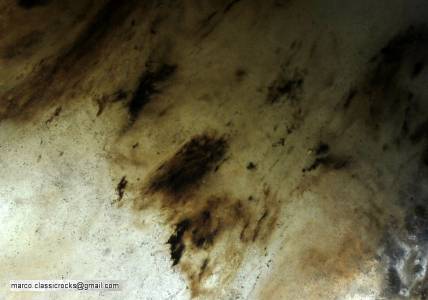

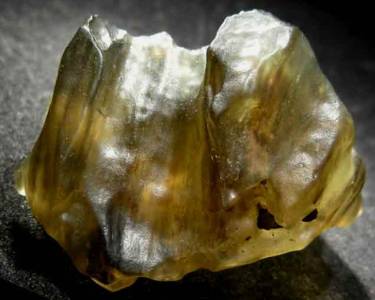
Dark streaks and bands
|
|
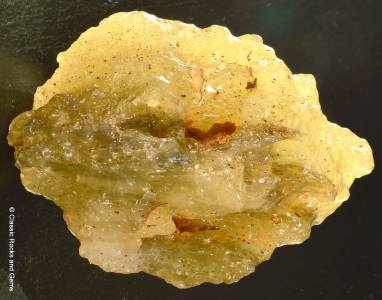
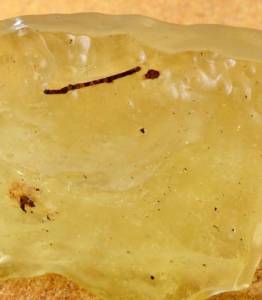
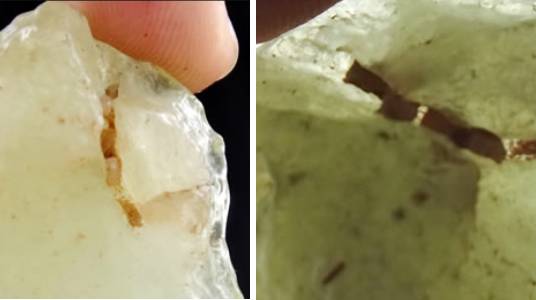
|
|
Stalks or graphite ribbons ?
|
|
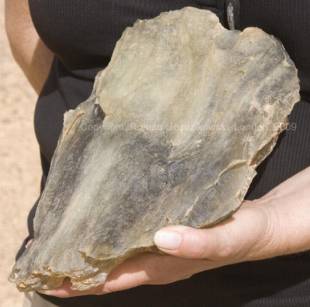
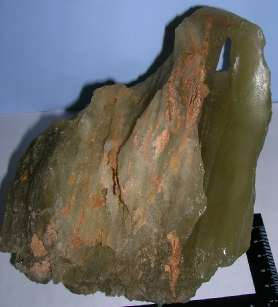
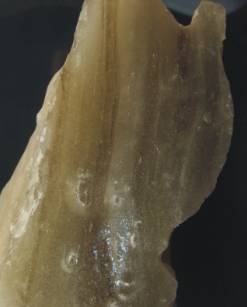
|
Large pieces
of LDG
|
Laminated
LDG
|
|
|

Silica-strewnfield in context with relevant
structures
|

|
|
Fission-track
dating of the Libyan Desert Glass by BIGAZZIi & De
MICHELE, 1995 |
|
|
Sample 1
|
Sample 2 |
Sample 3 |
Sample 4 |
|
Heating
|
Age (Ma) |
+/- |
Age (Ma) |
+/- |
Age (Ma) |
+/- |
Age (Ma) |
+/- |
|
ambient
|
26.3 |
1.4 |
|
|
|
|
|
|
|
ambient
|
27.0 |
2.0 |
26.0 |
1.8 |
29.0 |
1.8 |
28.8 |
1.9 |
|
220�C
|
28.0 |
1.9 |
28.2 |
1.4 |
|
|
|
|
|
270�C
|
30.2 |
2.0 |
25.3 |
1.3 |
|
|
28.7 |
1.9 |
|
320�C
|
|
|
29.4 |
2.0 |
|
|
29.4 |
1.8 |
|
370�C
|
28.5 |
2.5 |
27.9 |
2.2 |
|
|
28.4 |
2.2 |
This datings with a weighted mean of 28.5 +/-
0.8 Ma confirm in principle the age quoted by STORZER & WAGNER,
1977 in their list (25.9 +/-0.4 Ma)
|
Origin of the Libyan Desert Glass
The origin of the LDG is up to now unsolved
despite all efforts. The majority of specialists favor an origin by
an impact. There are however some differences to "classical" impact
glasses. There is also no credible references for an impact event in
the region. It is also not plausible, that a mass of ~1400 tons of clean
glass is produced by an impact event (or an air burst). It is not conceivable,
that for a so great quantity of LDG an ground-reservoir of pure silicium-sand
was available, which then was melted by an extra-terrestrial event.
Besides the desert not exist in the Oligocene age. The surface was dominated
by consolidated "Nubian"sandstones.
It is therefore not to be doubted that the LDG was caused by a purely
terrestrial event. Meanwhile, there is enough geological and geochemical
evidence for it. An exterrestrial origin (impact or airburst) is excluded,
it is nonsense.
The LDG is according the mid-infrared
reflectance an unique low-water silica fluid (opaline glass/ hyalite).
Remarkable are polygonalized graphite ribbons and Al-rich pyroxene phenocrysts
in the groundmass (see publications below) what indicate the origin
from enormous deeps.
-
The LDG strewnfield
is located on a SW-NE fault line, where a large block of the
Archean-Proterozoic Basement were uplifted about 2000 m above
its original level to the present terrain surface (Uweinat-Howar
Uplift).
-
The entire region
is characterized by intense
sub-volcanic
activities, during which hundreds of crater-like structures,
plugs and dykes have been created.
-
The Oligocene age
of these structures, some of which are visibly associated with
basaltic intrusions, is conform to that of LDG.
-
In the meantime,
unique boulders of
magnetic
Silica rocks have been found south of the Silica strewnfield
containing magnetite and inclusions in the form of high temperature
quartz drops (tridymite).
-
The findings of "sub-micrometer
diamonds in an amorphous, carbon-dominated matrix" in LDG are
a clear indication for the origin of the glass melt from enormous
depths.
-
Also remarkable is
the detection of many small
diamonds
in breccias that were found in the Silica strewnfield.
-
The findings of "sub-micrometer
diamonds in an amorphous, carbon-dominated matrix" in LDG itself
are a clear indication for the origin of the glass melt from
enormous depths.
-
In this context include
the extraordinary stone "Hypatia"
(carbonaceous, diamond-bearing stone), as well as the polymetallic
and carbonaceous debris in paleosol, which were found in the
LDG strewn field, nearby the uplift-main-fault.
-
Sensational is the
detection of altered Al-rich orthopyroxenes in the LDG,
which document a connection to a magma.
-
The iridium and other
rare elements contained in the glass are no problem. On the
contrary, they support the obvious source of the molten glass
from the Earth's crust or deeper.
-
In addition to the
entire spectrum of different quartz crystallization, further
inclusions and dark zones (accumulation of metals) can be find,
which, due to their texture, document a flow of the silica mass.
-
A tremendous sensation
is the discovery of a
kimberlite breccia from a crater-like structure in the western
direction of the strewnfield containing perhaps diamonds at
the surface. Proved, however, are large
dark brown diamonds in a breccia of the structure Qaret-el-Hanash
in the immediate south-southeast of the strewnfield field, which
would have to be a kimberlite pipe.
-
Very interesting
in this context are the finds of relocated Al-rich "Dakhla
Glass" in a paleo-lake. It contains a considerable amount
of pyroxenes and is an andesitic lava due to its composition.
-
An very interisting object from a dune
corridors that is not pure Libyan Desert Glass. The matrix
of the selected part signals a rock from the Earth's mantle.
There are big altered inclusions, which were most likely
olivine. The object was enclosed in greenish LDG, which the
owner said had been removed.
Here we have the ultimate proof of the origin of the LDG
from the Earth's mantle !
|

Structural-geological model
|
In the context
with all this phenomena, the locality of LDG, the structural-geological
model as well as the common age of the Desert Glass und all the
subvolcanic structures it is possible to solve the mystery around
the origin the LDG:
The root of initially fluide amorphous
Silica (lechatelierite), with melt temperatures of about 1800�C
or more, could be a gabbroide magma plume. The findings of "sub-micrometer
diamonds in an amorphous, carbon-dominated matrix" are a clear
indication for the origin of the Silica from enomous hypabyssal
depths. The presence of high-temperature minerals of quartz, as
well as baddeleyite, a high-temperature breakdown product of zircon
document temperatures in a slowly ascending and down-cooling initally
silica solution. The digestion of high-temperature mineral silica
phases up to the stage of formation of lower temperature alpha-cristobalite
indicates a constantly progressive cooling of the mass.
It is well possible, that a SiO2-rich solution have climbed
the earth's surface along the main-fault of the Uweinat-Howar
Uplift. SiO2-rich fluide amorphous mass have separated themselves
from the magma body with a amount of supercritical water. This
supercritical water will then continuously separate from the melt
at lower temperature (374�C, pressure 22GPa). The SiO2-rich mass
will than consolidated consequently (with loss of water) to an
gel of pure natural glass. Special flow marks in the glass speak
for a flow of the mass at the earth's surface like slow-moving
lava.
|
|
|

Different Silica pieces
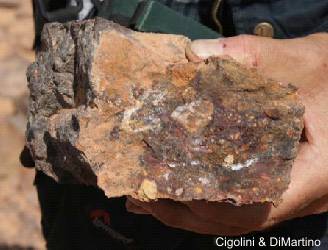
Crater
Zerzura: Kimberlite breccia
|

Silicified sandstone in the dune
corridor
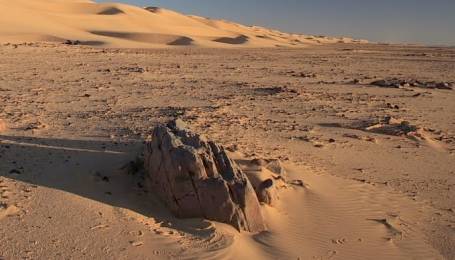
Tilted layers
|
|


Qaret-el-Hanash:
Hill south of Silica -- Kimberlite breccias contain debris of basement,
jasper and a dark glassy melt as well as large dark brown diamonds
Location: 25�04'46'' N / 25�56'02'' E
|
|

Striking hill with fused sandstones
at the presumed Aqaba fault line
|
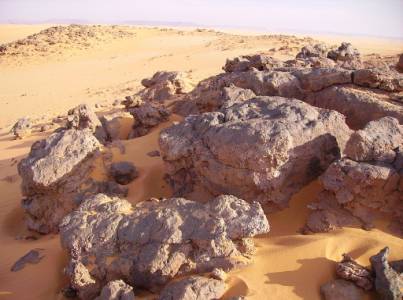
Other place with fused sandstone
at the presumed Aqaba fault line
Position: 23� 58' N / 25� 37' E
|
|

Red volcanogenic zone with the
hill of fused sandstone
|

|
|
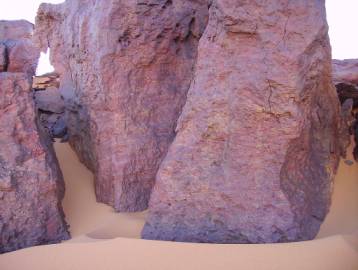
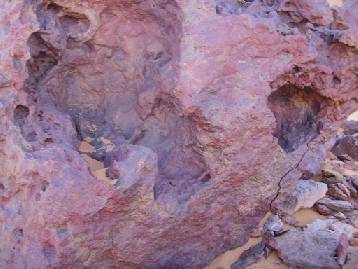
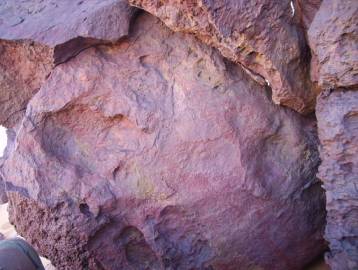
Fused sandstone
|
|
Some Publications
|
Thermal characterisation of Australian sedimentary and volcanic
precious opal
A.G. Smallwood,
P.S. Thomas and A.S. Ray -- Journal of the Australian Ceramic Society
Volume 44[2], 2008, 17-22, PDF
"Opal-AN is opaline silica that is
deposited in thin otryoidal crusts on volcanic rocks by quenching
from high temperature silica fluids. Opal-AN, although a natural
hydrous silica, has a much lower water content that opal-AG and
has properties that are much more akin to silica glasses. Examples
of this type of silica are hyalite or Libyan
Desert Glass."
|
|
Donald Kasper, Lancaster, California (unpublished)
"I have master references of some volcanic and "impact" glasses
as well of the Libyan Desert Glass (LDG) from the mid-infrared reflectance
(Magna 560 spectrometer). The result is that the LDG is not glass,
not agate, opal, or jasper. It does, however, very precisely match
hyalite in infrared (right). Volcanic glass (obsidian etc.)
alleged impact glass, tektites - all the glass and tektites match
volcanic rocks. For proper volcanic identification, first we have
to see a suite of additional 1200 cm region spectral bands not found
in the literature due to the limitations of using transmission infrared
instead of reflectance used here.
The LDG is a vapor-deposition of silica in
volcanics. The comparison hyalite specimen coming from the
Czech Republic. The hyalite is a glass-like opal, usually found
associated with volcanic rocks, has characteristics different from
other types of opal."
|

|
Mullite in Libyan Desert Glass:
Evidence for high-temperature/low-pressure formation
Ansgar Greshake et al.
-- The Meteoritical Society, Volume
53, Issue 3, March 2018
https://doi.org/10.1111/maps.13030"We
report on the finding of a lens-shaped
whitish inclusion within LDG. The object is dominantly
composed of siliceous glass and separated from the surrounding
LDG by numerous cristobalite grains. Within cristobalite, several
regions rich in mullite often associated
with ilmenite were detected. Cristobalite contains concentric
and irregular internal cracks and is intensely twinned, indicating
that first crystallized β-cristobalite inverted to α-cristobalite
during cooling of the SiO2-rich melt. The accompanied volume
reduction of 4% induced the high density of defects. The whitish
inclusion also contains several partly molten rutile grains
evidencing that at least locally the LDG melt was at T ≥ 1800
�C."
Note:
Mullite is formed in
magmatic rocks as a decomposition product of sillimanite (sillimanite
→ mullite + SiO2). Sillimanite is a nesosilicate from the group
of aluminosilicates and is considered as a indicator for the
thermodynamic transformations of andalusite and kyanite in rocks
of the amphibolite and granulite facies.
|

|
|
Brownish inclusions and dark streaks in Libyan Desert Glass
A. Greshake, Ch. Koeberl, J. Fritz and U. Reimold
-- Meteoritics & Planetary Science, 45, 6
https://www.researchgate.net/publication/253922005 or
http://onlinelibrary.wiley.com/doi/10.1111/j.1945-5100.2010.01283.x/full
Dark streaks and different types of inclusions in Libyan Desert
Glass (LDG) collected from the LDG strewn field in Egypt were investigated:
Transparent Spherules
The spherules generally occur as distinct single objects; only rarely
two or more are found in close proximity to each other. They are
separated from LDG matrix by concentric cracks and contain a high
density of internal cracks, which do not extend into the surrounding
glass. Sometimes these cracks are curved and delimit rounded subgrains
resembling some features of ballen silica, although the rounding
of subgrains is not as regular as normally observed in ballen silica.
Tiny bubbles are abundant in the spherules and cause partial brownish
staining. Viewed with cross polarized light, the spherules appear
completely birefringent and show pronounced twin lamellae. Electron
microprobe analyses indicate that the spherules have, on average,
higher SiO2 (approximately 99.8 wt%) and lower major oxide concentrations
(e.g., Al2O3, MgO, FeO, and TiO2) than the surrounding LDG glass.
Accordingly, they appear slightly darker in BSE images compared
to LDG matrix. Raman spectra recorded on various spherules show
pronounced peaks at 230 and 418 cm-1 and smaller peaks
at 780 and 1076 cm-1, which are diagnostic for
alpha-cristobalite. In some
spectra the peak at 780 cm-1 is shifted to 793 cm-1,
which might be attributed to the intense twinning."
Brownish Inclusions (Al-rich
orthopyroxene* )
"Brownish inclusions are irregularly shaped, elongated objects that
exhibit smooth contacts to the surrounding glass, with schlieren
extending from the inclusions into the glass matrix. Optical microscopy
reveals that the inclusions are composed of numerous very small
bubbles causing the brownish color and of subrounded to rounded
mineral grains displaying higher refractive indices than the surrounding
glass. While some of these phases appear as small roundish to elliptical
droplets, a few larger and more angular grains exist. Generally,
all phases within the inclusions appear isotropic when viewed under
cross polarized light.
Electron microprobe analysis revealed that angular grains and droplets
have very similar chemical compositions. All these phases contain
considerable amounts of silica (approximately 53�54 wt% SiO2) with
approximately 5�6 wt% Al2O3, approximately 23�24 wt% MgO, approximately
14�15 wt% FeO, and minor concentrations of TiO2, Cr2 O3, MnO, and
CaO. Analyses also indicate poor stoichiometry of the phases attesting
to a low degree of crystallinity. These compositions most closely
resemble that of an Al-rich orthopyroxene.
According to X-ray elemental mapping, the angular grains and droplets
are compositionally homogeneous and do not show any chemical zoning.
Due to the high porosity of the two birefringent grains, their electron
microprobe analyses are also nonstoichiometric and yielded totals
between 95.5 and 99.1 wt%. Although containing slightly less Al
than the droplets, the overall composition of the birefringent grains
closely resembles that of the isotropic grains and droplets. Raman
spectra obtained from the different isotropic grains and droplets
are characterized by two broad features at approximately 570 and
960 cm-1 attesting to their amorphous nature or very
low degree of crystallinity.
In contrast, Raman spectra collected from the birefringent grains
show several distinct peaks, which are clearly recognizable despite
a strong fluorescence. The most prominent Raman bands are found
at ~340, ~385, ~464, ~655, ~674, ~839, ~935, and ~1001 cm-1.
According to systematic Raman studies of pyroxenes, these bands,
especially the splitting of the doublet in the 650�680 cm-1
region, are typical for orthopyroxene.
Compositions and Raman spectra clearly indicate that all pyroxene-like
phases observed in the brownish inclusions were at least partially
molten....and that no low-Ca, Al-rich pyroxene phenocrysts are present
in the glassy groundmass. Hence, the pyroxene-like phases are clearly
not co-genetic."
*
Pyroxenes occur dominantly in rocks formed under high ambient pressure,
e.g., in a hypersthene-cordierite-biotite granulite, in granulite
xenoliths from the lower continental crust, and in a bronzite from
a high-pressure megacryst in an alkaline lava.
Dark Streaks
"The dark streaks investigated in this study appear as 0.3 to about
1 mm wide wavy bands that continue for about 1�3 cm almost parallel
within the light greenish glass fragment. Intensity of the brownish
staining varies locally from weak to strong over several millimeters.
Optical microscopy revealed that these bands resemble turbulent
flow structures that do not contain any discernable mineral phases
at the millimeter scale. Differently shaped bubbles are quite abundant
within the streaks and sometimes appear as nucleation sites for
the bands. In high contrast BSE images the streaks are clearly discernable
and appear as curved, variably gray-colored bands or as lenticular
regions with pronounced flow textures. Electron microprobe analyses
and X-ray elemental mapping of several regions within streaks show
a strongly heterogeneous distribution of Al, Si, Mg, and��more rarely
and less pronounced��of Fe and Ti. Generally, the Si-rich regions
appear darker in BSE imaging, whereas those with higher Al and Mg
contents are brighter. Variations in Al abundances allow tracking
the flow structures observed in BSE mode.
The Micro-XRF mapping clearly shows enrichments and good correlation
of the abundances of Mn, Cr, Fe, and Ni in the dark streaks. The
Ti-distribution also shows pronounced schlieren structures, which
appear, however, not related to the Fe maximum intensity. The Zr
distribution map shows the presence of distinct Zr-rich spots, probably
zircon or baddeleyite.
The concentrations of the elements Cr, Mn, and Ni were extrapolated
using the linear correlation of peak intensity and element concentration
determined in different standards and should be taken as semi-quantitative.
The concentrations for dark and light areas, respectively, are for
Ti 920 and 780 ppm and for Fe 4900 and 1160 ppm. In the dark streaks
the concentration of Cr is 170 ppm, that for Mn 74 ppm, and for
Ni 80 ppm; the concentrations of these elements are below the detection
limit in the light regions.
Raman spectra recorded from the dark streaks are featureless and
confirm that no crystalline phase is present in the bands." |
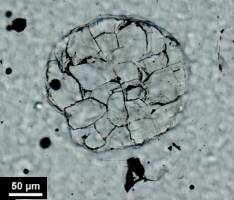

Alpha-Cristobalite
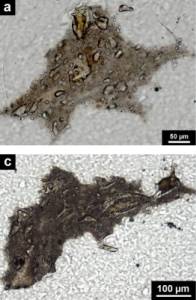
Altered orthopyroxes
|
|
|
Libyan Desert Glass: new filed and Fourier Transform InfraRed data
F. Fröhlich, G. Poupeau, A. Badou, F. X. Le
Bourdonnec, Y. Sacquin, S. Dubernet, J. M. Bardintzeff, M. Veran, D.
C. Smith, and E. Diemer --
Meteoritics & Planetary Science, Volume 48, Issue 12, pages 2517�2530,
December 2013
"All of LDG IR spectra exhibit the three IR active
absorption bands typical for condensed (SiO4) tetrahedra that are predicted
by theoretical considerations. The bands near 1100 and 471 cm-1
are assigned to degenerated vibration modes of the (SiO4) tetrahedral
unit, respectively, stretching (n Si-O) and bending (d Si-O) (Lecomte
1949).
The n Si-O band is quite stable at 471�472 cm-1
for amorphous phases. The wave number of the m Si-O band is affected
by the surroundings of the unit tetrahedron (Lecomte 1949); for crystalline
silica phases (e.g., quartz, cristobalite, opal-CT), it is regarded
as the envelope of several, poorly resolved bands; then delta
n and I are less significant than for amorphous phases. For LDG
samples and fulgurite, the wave number of this band is not very variable
around 1103 cm-1,
whereas the wave number values for fused quartz and amorphous biogenic
silica are lower, respectively, 1101 and 1100 cm-1.
The absorbance, the half-width, and the integrated intensity vary rather
widely, whereas they are stable for crystalline phases.
The third, weaker band, near 800 cm-1,
is assigned to a vibration of the bridging oxygen atom in the plane
of the Si-O-Si bonds, between the adjacent tetrahedra (Lecomte 1949).
The relative motion results in a deformation of the Si-O-Si angle in
the direction of its bissectrix (Parke 1974)."
"In polished thin sections, LDG appears as a homogeneous
glass with spherical bubbles and mainly tubular cavities. Sometimes
they are at least partly filled with sand grains and/or hardened silt.
The millimeter-sized (and smaller) whitish polycrystalline spherical
inclusions visible inside the LDG volume were identified by FTIR (and
also by Raman spectroscopy) as cristobalite concentrations. Other mineral
inclusions were detected by SEM in BSE mode (backscattered electrons)
and determined by EDS. These included melted crystals (deduced on the
basis of their elliptical form) of monazite, a rare earth element (REE)
phosphate depleted or totally lacking in phosphorus as seen on their
EDS spectra, according to the three domains analyzed (in wt%: Al = 0.2�0.8%,
Si = 15.0�26.0%, O = 36.2�37.0%, P = <0.1�9.0%, Ca = <0.1�0.4%, La =
8.4�9.9%, Ce = 14.0�16.9%, Pr = <0.1�1.6%, Nd = 5.9�6.5%, Sm = <0.1�1.0%,
Gd = <0.1�0.8%, Th = 3.8�5.8%), and zircon (ZrSiO4) transformed into
a mixture of baddeleyite (ZrO2) and lechatelierite; both of these mineralogical
processes require great heating."
|
 |
|
Crystalline microstructures
in Libyan Desert Glass: Effect of microgravity environment
C. Patuelli, R. Serra, S. Coniglione, M. Chiarini
-- Microgravity and Space Station Utilization, vol. 3, no. 4, 2002
"Samples of Libyan Desert Glass were analyzed
by X-ray micro-diffraction technique. It was identified fourteen nano-sized
crystalline LDG phases with different colours: Coesite, tridymite,
stishovite, baddeleyite, huttonite, yttrium, moissanite, platinium,
polymorphs of diamond and graphite.
The four praphite polymorh phases found in LDG samples can be explained
by taking into account that the graphite came from the earlier history
of the material. The element platinum is extremely scarce in most crustal
rocks. The origin of platinum is from ultra-mafic igneous rocks. Its
melting point is 1775 �C. The zircon oxide mineral Baddeleyite is the
product of the decomposition of zircon at 1775� - 1900�C. Moissanite
is a natural silicon carbide (SiC). Huttonite is a low-temperature and
low-pressure Thorite-polymorph (ThSiO2).
The identification of nine highbaric phases, the presence of hexagonal
diamond with four phases of graphite polymorphs, as well as huttonite
and baddeleyite, confirm that LDG formed by "shock metamorphism" at
very high pressure and temperature. The nano-sized crystalline phases
revealed point out that LDG rapidly solidified.
Preliminary X-ray micro-diffractometry analyses were presented at the
�Silica 96� workshop (Patuelli, 1997). High pressure and high temperature
phases were identified: including samarium, germanium 12T, thorium beta
(this beta phase occurs only at a temperature above 1350�C) and stishovite,
which is a high temperature and pressure form of SiO2."
|
|
Silicate-Silicate liquid immiscibility
and graphite ribbons in Libyan Desert Glass
G. Pratesi, C. Viti, C. Cipriani, M. Mellini -- Geochimica et Cosmochimica
Acta, March 2002
"Transmission electron microscopic (TEM) investigation of the dark (brown
or bluish) streaks occurring in Libyan Desert Glass reveals the common
presence of small glass spherules. The spherules, mostly 100
nm in size, are homogeneously dispersed within the silica-glass matrix.
The complete absence of electron diffraction effects confirms their
amorphous nature. The spherules are Al-, Fe- and Mg-enriched with respect
to the surrounding silica matrix and their (Mg+Al+Fe) : Si ratio is
close to 1. The silica-glass matrix and amorphous spherules form an
emulsion texture (i.e., globules of one glass in a matrix of another
glass), which originates from silicate-silicate liquid immiscibility.
The silica glass also contains carbonaceous inclusions consisting of
5�50 nm thick, polygonalized graphite ribbons that form closed
structures up to 200 nm in diameter.
3.3. Graphite inclusions
Rare carbon-bearing inclusions randomly occur within the silica-glass
matrix. Their presence is ubiquitous and not limited to the regions
with dark streaks. C-bearing inclusions produce an evident C peak in
the EDS spectra. The inclusions consist of ring-shaped polygonalized
ribbons, 5�50 nm thick, typically forming closed structures with an
overall diameter of ~200 nm. Their SAED patterns consist of rings with
d-spacings of 3.35, 2.09 and 1.67 A: these values correspond to graphite
(3.36, 2.13-2.03, 1.678 A, JCPDS 23-64). Lattice imaging shows 3.35
A polygonized (002) lattice fringes. The fringes are quite regular,
thus indicating good structural order with no evidence of deformation
or defects. Dark vertical bands are evident at the polygonal edges and
are interpreted as Moire textures."
|
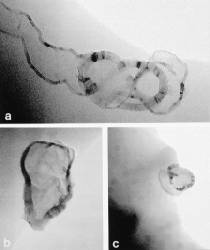
Graphite polymorphs |
|
Liquid immiscibility
and gas content in dark schlieren of Libyan Desert Glass
M. C. Bölitz & F.
Langenhorst, Bayerisches Geoinstitut, Universität Bayreuth, Germany
http://www.lpi.usra.edu/meetings/lpsc2009/pdf/2018.pdf
"In this study we have focused on the chemical
and textural characteristics of dark schlieren. Our investigation aims
at obtaining further information on the cooling history and precursor
material of LDG.
Backscattered electron (BSE) images were taken on the SEM and microprobe
in order to monitor chemical variations in LDG and to detect tiny inclusions.
Schlieren-free, bulk LDG samples show only slight variations in chemistry,
with two different grayscales in BSE images. Dark grey, lens-like areas
consist of almost pure SiO2 and thus represent lechatelierite, the melt
product of quartz. Bright grey areas have on average a SiO2 content
of 98 � 99 wt.%; additional minor elements are Mg, Fe, Al, Ca, K, and
Na.
Compared to the bulk glass, the brownish-black schlieren in LDG are
distinctly enriched in Mg, Fe, and Al; the concentrations of measured
trace elements such as Ti, Ni, Cr, and La are equally enhanced. In some
parts of schlieren the SiO2 content decreases down to 86 wt %. Within
the dark schlieren we observe furthermore distinctly larger chemical
variations than in the bulk glass sample.
BSE images indicate that there are two types of dark schlieren. One type of
dark schlieren consists exclusively of tiny, mostly 100 nm in size,
glass spherules. This type of schlieren have been previously described
in a transmission electron microscopy study, as well. In comparison
to the glass matrix, the spherules are enriched in Al, Fe, Mg, and Ni
and depleted in Ca.
The other type of dark schlieren displays flow structures and large,
up to 25 μm diameter glass spherules. The overall texture of these schlieren
indicates an immiscibility of two silicate liquids. To detect the miscibility
gap, the chemical compositions of spherules and the surrounding groundmass
in dark schlieren have been measured with the microprobe and are plotted
in a ternary MgO-Al2O3-SiO2 diagram. The analytical data define a trend
that deviates from the known stable miscibility gap along the MgO-SiO2
join. Instead, the data points follow closely the Al2O3-SiO2 tie line,
along which a metastabile miscibility gap has been described.
Microprobe analyses of spherules and ground-mass in dark schlieren of
LDG. The ternary plot shows also the known stable miscibility gap along
the MgO-SiO2 join.
LDG samples with and without black schlieren were stepwisely heated
up to 1450�C. In both samples, bursting bubbles released mostly H2O
and CO2. The black schlieren contain however one order of magnitude
more H2O and CO2 than the bulk silica glass. Another difference between
black schlieren and bulk glass concerns the temperatures of gas release.
For example, CO2 is released from black schlieren in two temperature
intervals between 250� - 300�C and 450� - 550�C. In the bulk sample,
CO2 is however only liberated in the upper temperature interval between
420� - 650�C.
The data presented here provide hints to the
cooling history of LDG and the precursor material of dark schlieren.
Microprobe data of glass spherules and surrounding matrix in dark schlieren
indicate that the compositions of the two immiscible silicate liquids
are close to the Al2O3-SiO2 join. According to experimental studies,
this binary system displays only metastable immiscibility for very rapid
cooling of the melt, as it is expected for LDG.
DEGAS analyses reveal that dark schlieren are
distinctly richer in volatiles, particularly in H2O, than bulk LDG.
It is thus likely that the precursor material might have contained
hydrous phases."
|
|